A Hot Water Split-Flow Dual-Pressure Strategy to Improve System Performance for Organic Rankine Cycle
Abstract
:1. Introduction
2. System Description
2.1. Basic ORC System
2.2. Conventional Dual-Pressure ORC System
2.3. Split-Flow Dual-Pressure ORC System
3. Mathematical Model
3.1. Assumptions
- The system operates under a steady state.
- In the B-ORC system, the working fluid liquid at the outlet of the working fluid pump is heated to the saturated liquid in the preheater, and then the saturated liquid at the outlet of the preheater is heated to the saturated vapor in the evaporator. In the CD-ORC and SFD-ORC systems, the working fluid liquid at the outlet of the high-pressure working fluid pump or the low-pressure working fluid pump is heated to the saturated liquid state in the preheater of the corresponding loop, and then the saturated liquid at the outlet of the high-pressure preheater and the low-pressure preheater is heated to the saturated vapor in the evaporator of the corresponding loop.
- The working fluid at the outlet of condenser is in a saturated liquid state.
- The inlet temperature of the hot water and the cooling water are constant.
- The changes in kinetic and potential energy are neglected.
- The friction loss and energy loss in the evaporator, condenser and any pipeline are neglected.
- The condensation temperature of the working fluid is constant.
- The cooling water pump and working fluid pump have a constant isentropic efficiency and mechanical efficiency.
- The expander has a constant isentropic efficiency and mechanical efficiency.
3.2. Thermodynamic Model
3.2.1. B-ORC System
- The process from state 1 to 2
- The process from state 2 to 3
- The process from state 3 to 4
- The process from state 4 to 5
- The process from state 5 to 1
3.2.2. CD-ORC System
- The process from state 1′ to 2
- The process from state 1″ to 2
- The process from state 2 to 3
- The process from state 3 to 4′
- The process from state 3 to 4″
- The process from state 4′ to 5′
- The process from state 4″ to 5″
- The process from state 5′ to 1′
- The process from state 5″ to 1″
3.2.3. SFD-ORC System
- The process from state 1′ to 2
- The process from state 1″ to 2
- The process from state 2 to 3
- The process from state 3 to 4′
- The process from state 3 to 4″
- The process from state 4′ to 5′
- The process from state 4″ to 5″
- The process from state 5′ to 1′
- The process from state 5″ to 1″
3.3. Solution
4. Genetic Algorithm Method Schemes
5. Results and Discussion
5.1. Independent Parameters on Net Power Output
5.2. The Effect of Independent Parameters on Net Power Output
5.3. Evaluation of the Genetic Algorithm Method
5.4. Optimal Parameters
5.5. The Maximum Net Output Power
6. Conclusions
- (1)
- The optimal hot water outlet temperature of B-ORC is much higher than that of CD-ORC and SFD-ORC, which indicates less thermal energy could be utilized to convert to power in B-ORC.
- (2)
- The optimal hot water temperature at the outlet of evaporator 1 in SFD-ORC is higher than that in CD-ORC, which means that SFD-ORC could make more efficient use of high-grade thermal energy of hot water.
- (3)
- SFD-ORC has the highest maximum net output power, and B-ORC has the lowest.
- (4)
- With the increase in hot water inlet temperature, the advantage of SFD-ORC becomes increasingly obvious. This indicates that SFD-ORC is more preferable for heat sources of a higher temperature.
- (5)
- SFD-ORC has great advantages in improving net output power.
Author Contributions
Funding
Conflicts of Interest
Nomenclature
| A | area (of heat exchanger) (m2) |
| cp | specific heat at constant pressure (kJ/(kg∙°C)) |
| h | specific enthalpy (kJ/kg) |
| K | heat transfer coefficient (W/(m2∙°C)) |
| m | mass flow rate (kg/s) |
| Q | heat transfer rate (kW) |
| t | temperature (°C) |
| T | thermodynamic temperature (K) |
| W | power (kW) |
| ∆P | pressure difference (Pa) |
| ∆T | logarithmic mean temperature difference (K) |
Greek symbols
| η | efficiency (%) |
| ρ | density (kg/m3) |
Subscripts
| AVG | average |
| cond | condenser |
| cond1 | condenser in high-pressure ORC |
| cond2 | condenser in low-pressure ORC |
| cw | cooling water |
| cwpump | cooling water pump |
| cw1 | cooling water exchange heat with high-pressure ORC |
| cw2 | cooling water exchange heat with low-pressure ORC |
| evap | evaporator |
| evap1 | high-pressure evaporator |
| evap2 | low-pressure evaporator |
| ex | exergetic |
| exp | expander |
| exp1 | high-pressure expander |
| exp2 | low-pressure expander |
| hw | hot water |
| hw′ | hot water split into high-pressure preheater |
| mid | between evaporator and preheater |
| net | net |
| pin | pinch temperature difference |
| pre | preheater |
| pump | working fluid pump |
| pump1 | high-pressure fluid pump |
| pump2 | low-pressure fluid pump |
| s | isentropic |
| th | thermal |
| wf | working fluid |
| wf1 | working fluid at high evaporation pressure |
| wf2 | working fluid at low evaporation pressure |
| 0 | environment |
Abbreviations
| ORC | basic organic Rankine cycle |
| CD-ORC | conventional dual-organic Rankine cycle |
| GA | genetic algorithm |
| GATBX | genetic algorithm toolbox |
| SFD-ORC | split-flow dual-organic Rankine cycle |
References
- Jouhara, H.; Khordehgah, N.; Almahmoud, S.; Delpech, B.; Chauhan, A.; Tassou, S.A. Waste Heat Recovery Technologies and Applications. Therm. Sci. Eng. Prog. 2018, 6, 268–289. [Google Scholar] [CrossRef]
- Walraven, D.; Laenen, B.; D’haeseleer, W. Comparison of thermodynamic cycles for power production from low-Temperature geothermal heat sources. Energy Convers. Manag. 2013, 66, 220–233. [Google Scholar] [CrossRef] [Green Version]
- Imran, M.; Hajlind, F.; Asim, M.; Alvi, J.Z. Recent research trends in organic Rankine cycle technology: A bibliometric approach. Renew. Sustain. Energy Rev. 2018, 81, 552–562. [Google Scholar] [CrossRef] [Green Version]
- Tocci, L.; Pal, T.; Pesmazoglou, I.; Franchetti, B. Small Scale Organic Rankine Cycle (ORC): A Techno-Economic Review. Energies 2017, 10, 413. [Google Scholar] [CrossRef]
- Peris, B.; Navarro-Esbrí, J.; Molés, F. Bottoming organic Rankine cycle configurations to increase Internal Combustion Engines power output from cooling water waste heat recovery. Appl. Therm. Eng. 2013, 61, 364–371. [Google Scholar] [CrossRef]
- Walraven, D.; Laenen, B.; D’haeseleer, W. Optimum configuration of shell-and-tube heat exchangers for the use in low-Temperature organic Rankine cycles. Energy Convers. Manag. 2014, 83, 177–187. [Google Scholar] [CrossRef] [Green Version]
- Walraven, D.; Laenen, B.; D’Haeseleer, W. Economic system optimization of air-Cooled organic Rankine cycles powered by low-Temperature geothermal heat sources. Energy 2015, 80, 104–113. [Google Scholar] [CrossRef] [Green Version]
- Walraven, D.; Laenen, B.; D’haeseleer, W. Minimizing the levelized cost of electricity production from low-temperature geothermal heat sources with ORCs: Water or air cooled? Appl. Energy 2015, 142, 144–153. [Google Scholar] [CrossRef] [Green Version]
- Usman, M.; Imran, M.; Yang, Y.; Lee, D.H.; Park, B.-S. Thermo-Economic comparison of air-Cooled and cooling tower based Organic Rankine Cycle (ORC) with R245fa and R1233zde as candidate working fluids for different geographical climate conditions. Energy 2017, 123, 353–366. [Google Scholar] [CrossRef]
- Haghparast, P.; Sorin, M.V.; Richard, M.A.; Nesreddine, H. Analysis and design optimization of an ejector integrated into an organic Rankine cycle. Appl. Therm. Eng. 2019, 159, 113979. [Google Scholar] [CrossRef]
- Zhang, C.; Lin, J.; Tan, Y. A theoretical study on a novel combined organic Rankine cycle and ejector heat pump. Energy 2019, 176, 81–90. [Google Scholar] [CrossRef]
- Rathod, D.; Xu, B.; Filipi, Z.; Hoffman, M. An experimentally validated, energy focused, optimal control strategy for an Organic Rankine Cycle waste heat recovery system. Appl. Energy 2019, 256, 113991. [Google Scholar] [CrossRef]
- Li, L.; Ge, Y.T.; Luo, X.; Tassou, S.A. Experimental investigations into power generation with low grade waste heat and R245fa Organic Rankine Cycles (ORCs). Appl. Therm. Eng. 2017, 115, 815–824. [Google Scholar] [CrossRef]
- Li, J.; Hu, S.; Yang, F.; Duan, Y.; Yang, Z. Thermo-Economic performance evaluation of emerging liquid-separated condensation method in single-Pressure and dual-Pressure evaporation organic Rankine cycle systems. Appl. Energy 2019, 256. [Google Scholar] [CrossRef]
- Li, T.; Zhang, Z.; Lu, J.; Yang, J.; Hu, Y. Two-Stage evaporation strategy to improve system performance for organic Rankine cycle. Appl. Energy 2019, 256, 113974. [Google Scholar] [CrossRef]
- Li, T.; Yuan, Z.; Li, W.; Yang, J.; Zhu, J. Strengthening mechanisms of two-stage evaporation strategy on system performance for organic Rankine cycle. Energy 2016, 101, 532–540. [Google Scholar] [CrossRef]
- Li, T.; Meng, N.; Liu, J.; Zhu, J.; Kong, X. Thermodynamic and economic evaluation of the organic Rankine cycle (ORC) and two-Stage series organic Rankine cycle (TSORC) for flue gas heat recovery. Energy Convers. Manag. 2019, 183, 816–829. [Google Scholar] [CrossRef]
- Wang, Q.; Wang, J.; Li, T.; Meng, N. Techno-Economic performance of two-Stage series evaporation organic Rankine cycle with dual-Level heat sources. Appl. Therm. Eng. 2020, 171, 115078. [Google Scholar] [CrossRef]
- Tang, Y. Single Stage and Cascaded Organic Rankine Cycles with Screw Expanders Used for Hot Fluids in Oil Refineries and Chemical Plants. In Proceedings of the International Refrigeration and Air Conditioning Conference, West Lafayette, IN, USA, 11–14 July 2016. [Google Scholar]
- Yari, M. Exergetic analysis of various types of geothermal power plants. Renew. Energy 2010, 35, 112–121. [Google Scholar] [CrossRef]
- Rashwan, S.S.; Dincer, I.; Mohany, A. Analysis and assessment of cascaded closed loop type organic Rankine cycle. Energy Convers. Manag. 2019, 184, 416–426. [Google Scholar] [CrossRef]
- Li, J.; Ge, Z.; Duan, Y.; Yang, Z.; Liu, Q. Parametric optimization and thermodynamic performance comparison of single-Pressure and dual-Pressure evaporation organic Rankine cycles. Appl. Energy 2018, 217, 409–421. [Google Scholar] [CrossRef]
- Cayer, E.; Galanis, N.; Nesreddine, H. Parametric study and optimization of a transcritical power cycle using a low temperature source. Appl. Energy 2010, 87, 1349–1357. [Google Scholar] [CrossRef]
- Wang, M.; Zhang, J.; Zhao, S.; Liu, Q.; Zhao, Y.; Wu, H. Performance investigation of transcritical and dual-pressure Organic Rankine Cycles from the aspect of thermal match. Energy Convers. Manag. 2019, 197. [Google Scholar] [CrossRef]
- Yu, X.; Li, Z.; Lu, Y.; Huang, R.; Roskilly, A. Investigation of an Innovative Cascade Cycle Combining a Trilateral Cycle and an Organic Rankine Cycle (TLC-ORC) for Industry or Transport Application. Energies 2018, 11, 3032. [Google Scholar] [CrossRef] [Green Version]
- Xi, H.; Li, M.-J.; Xu, C.; He, Y.-L. Parametric optimization of regenerative organic Rankine cycle (ORC) for low grade waste heat recovery using genetic algorithm. Energy 2013, 58, 473–482. [Google Scholar] [CrossRef]
- Palagi, L.; Sciubba, E.; Tocci, L. A neural network approach to the combined multi-Objective optimization of the thermodynamic cycle and the radial inflow turbine for Organic Rankine cycle applications. Appl. Energy 2019, 237, 210–226. [Google Scholar] [CrossRef]
- Kim, J.-S.; Kim, D.-Y.; Kim, Y.-T. Experiment on radial inflow turbines and performance prediction using deep neural network for the organic Rankine cycle. Appl. Therm. Eng. 2019, 149, 633–643. [Google Scholar] [CrossRef]
- Zhao, R.; Zhang, H.; Song, S.; Yang, F.; Hou, X.; Yang, Y. Global optimization of the diesel engine–organic Rankine cycle (ORC) combined system based on particle swarm optimizer (PSO). Energy Convers. Manag. 2018, 174, 248–259. [Google Scholar] [CrossRef]
- Valencia Ochoa, G.; Acevedo Peñaloza, C.; Duarte Forero, J. Thermoeconomic Optimization with PSO Algorithm of Waste Heat Recovery Systems Based on Organic Rankine Cycle System for a Natural Gas Engine. Energies 2019, 12, 4165. [Google Scholar] [CrossRef] [Green Version]
- Özkaraca, O.; Keçebaş, P.; Demircan, C.; Keçebaş, A. Thermodynamic Optimization of a Geothermal-Based Organic Rankine Cycle System Using an Artificial Bee Colony Algorithm. Energies 2017, 10, 1691. [Google Scholar] [CrossRef] [Green Version]
- Dong, S.; Zhang, Y.; He, Z.; Deng, N.; Yu, X.; Yao, S. Investigation of Support Vector Machine and Back Propagation Artificial Neural Network for performance prediction of the organic Rankine cycle system. Energy 2018, 144, 851–864. [Google Scholar] [CrossRef]
- MathWorks, Matlab. Available online: https://www.mathworks.cn/products/matlab.html (accessed on 21 March 2020).
- Nist, Refprop. Available online: https://www.nist.gov/srd/refprop (accessed on 15 January 2020).
- Lei, Y.; Zhang, S.; Li, X.; Zhou, C. Basic genetic algorithm and improvement. In Genetic Algorithm Toolbox; Long, H., Qi, W., Eds.; Xidian University Press: Shanxi, China, 2005; pp. 11–17. [Google Scholar]
- He, C.; Liu, C.; Gao, H.; Xie, H.; Li, Y.; Wu, S.; Xu, J. The optimal evaporation temperature and working fluids for subcritical organic Rankine cycle. Energy 2012, 38, 136–143. [Google Scholar] [CrossRef]
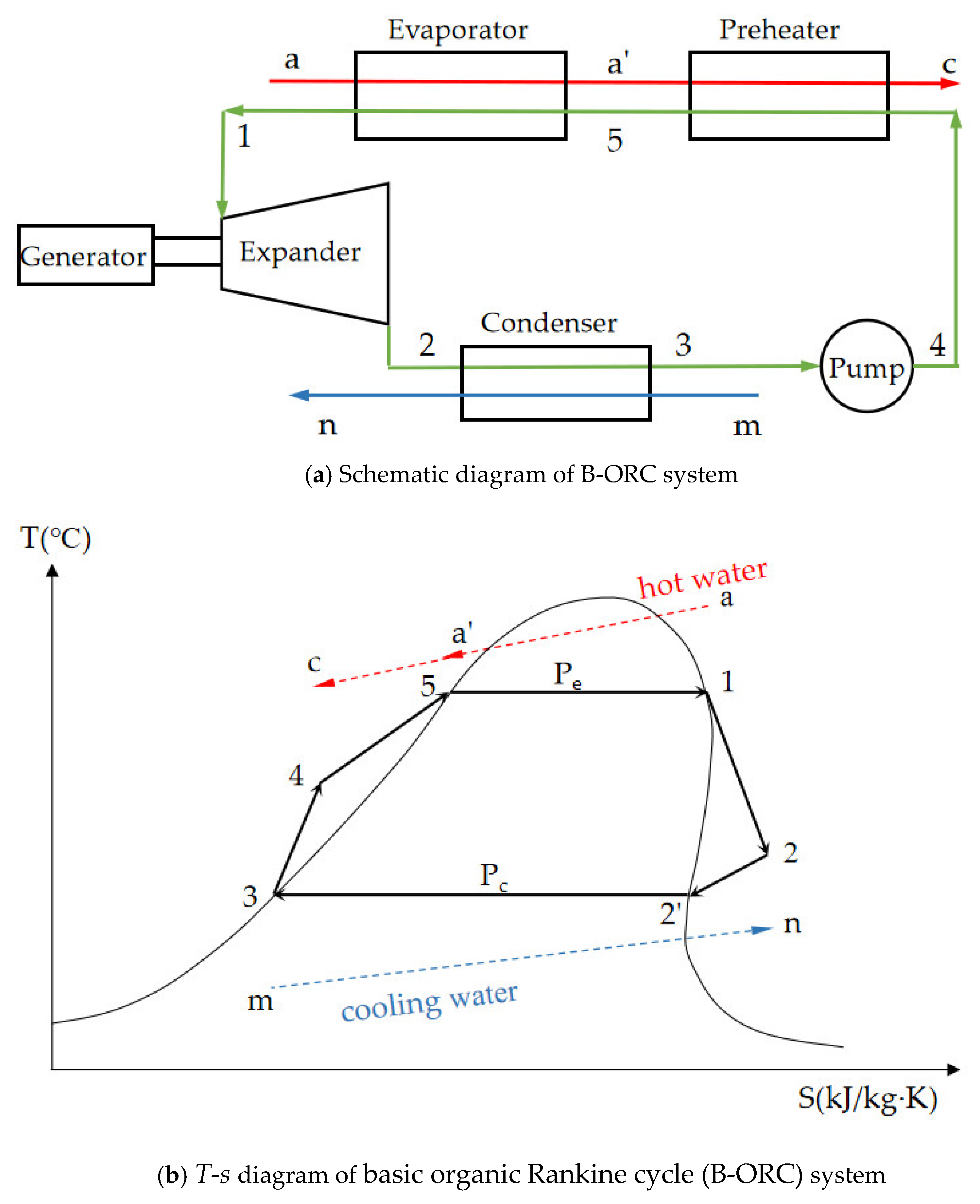
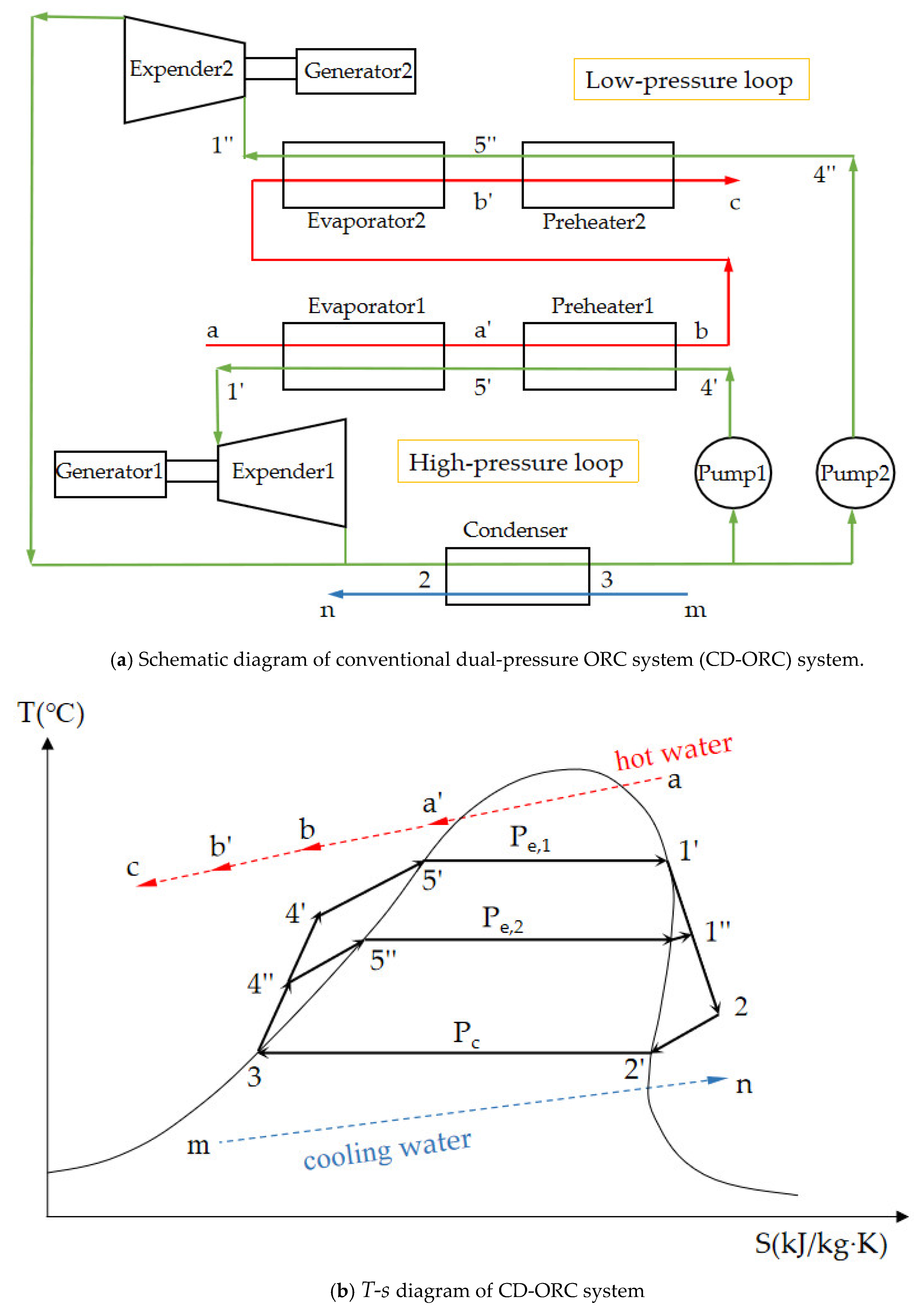
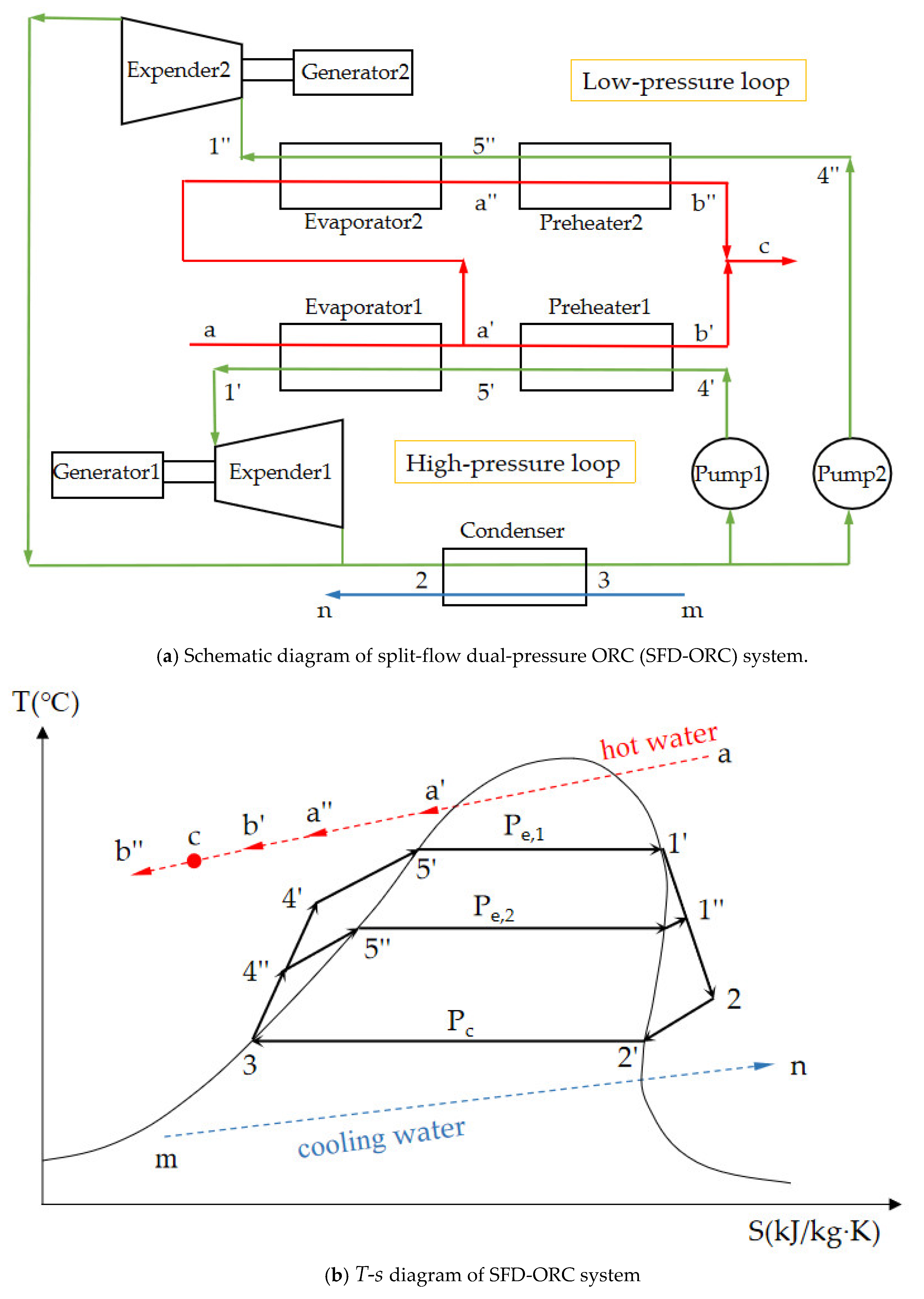
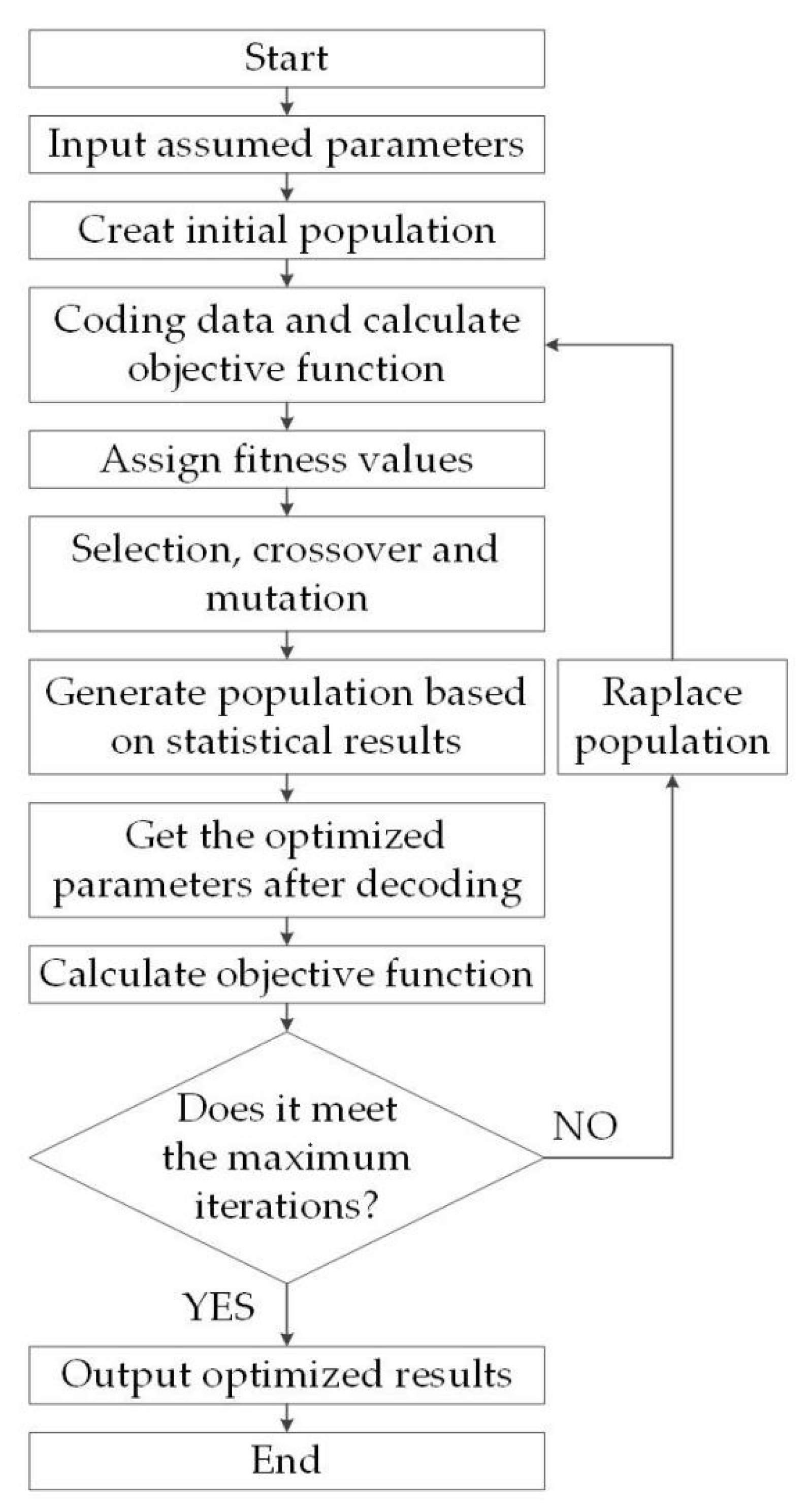
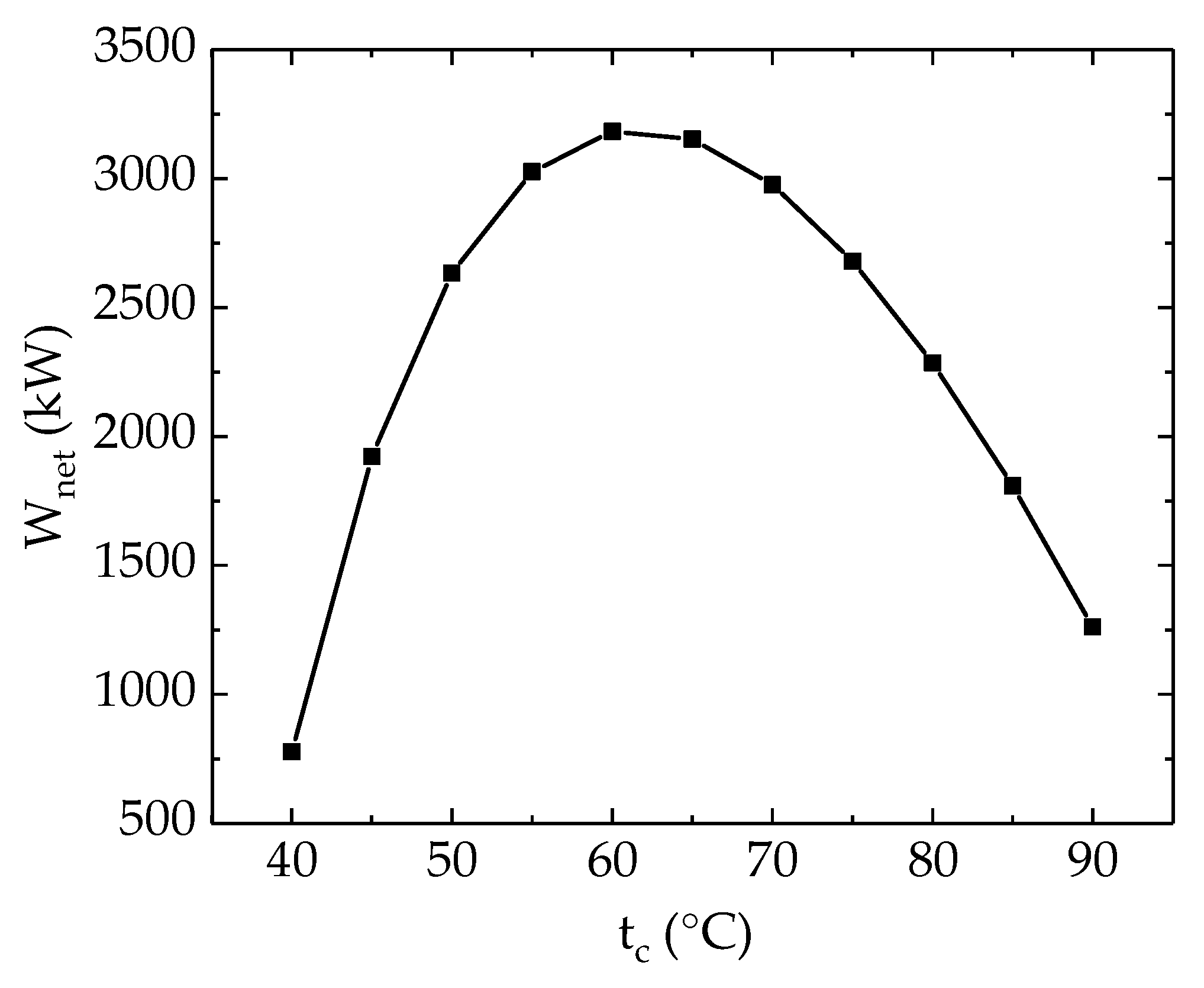
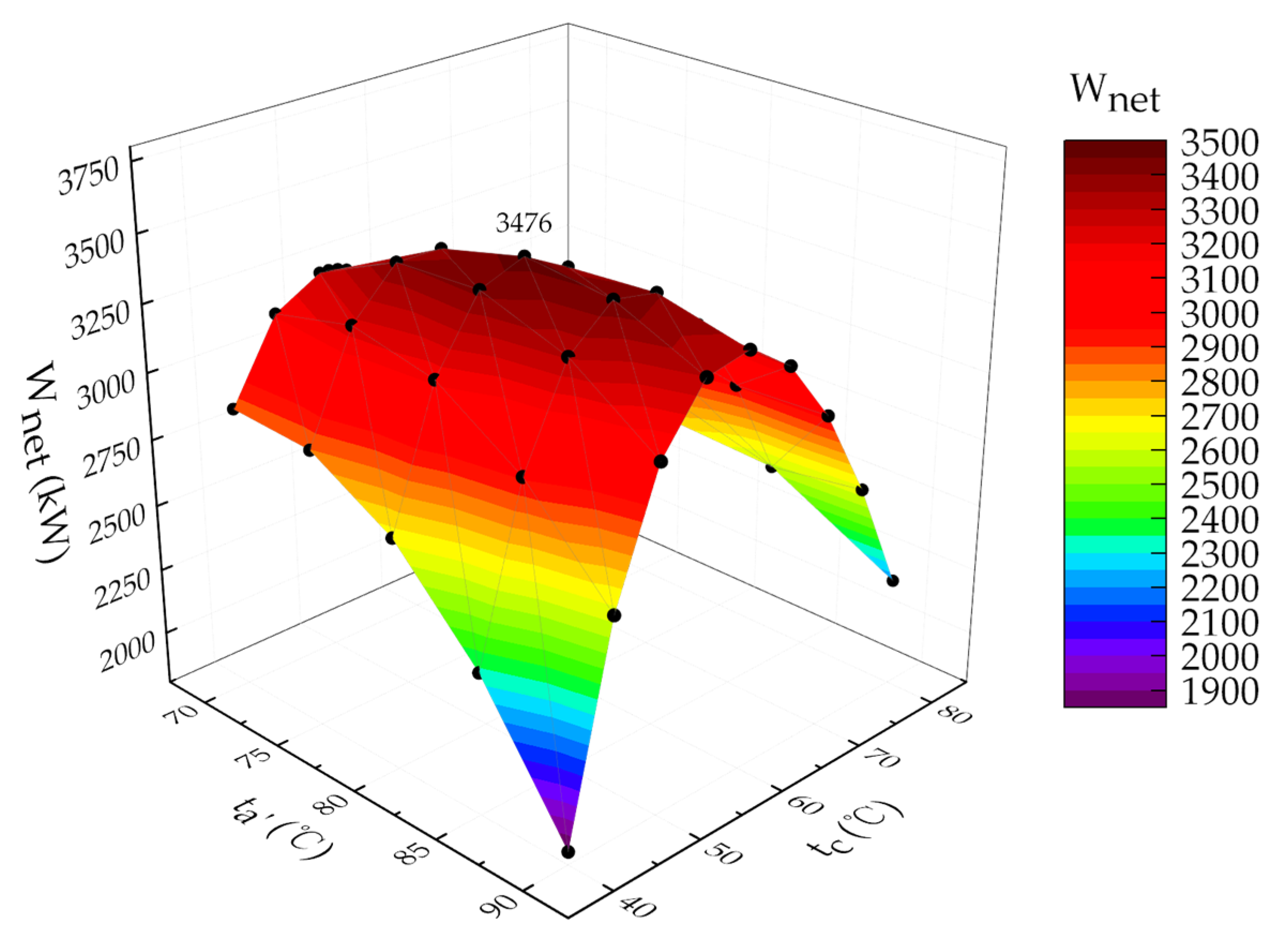
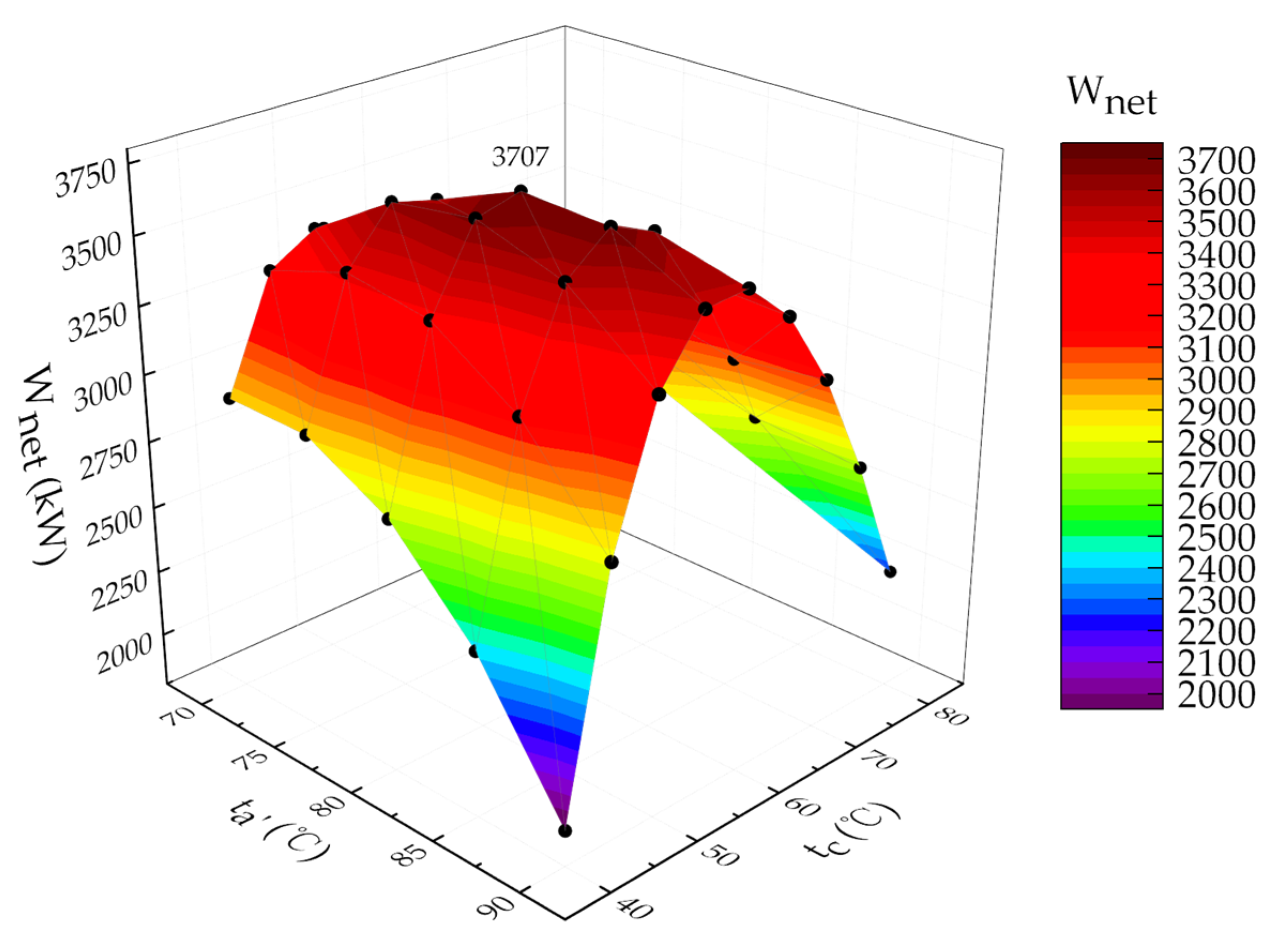
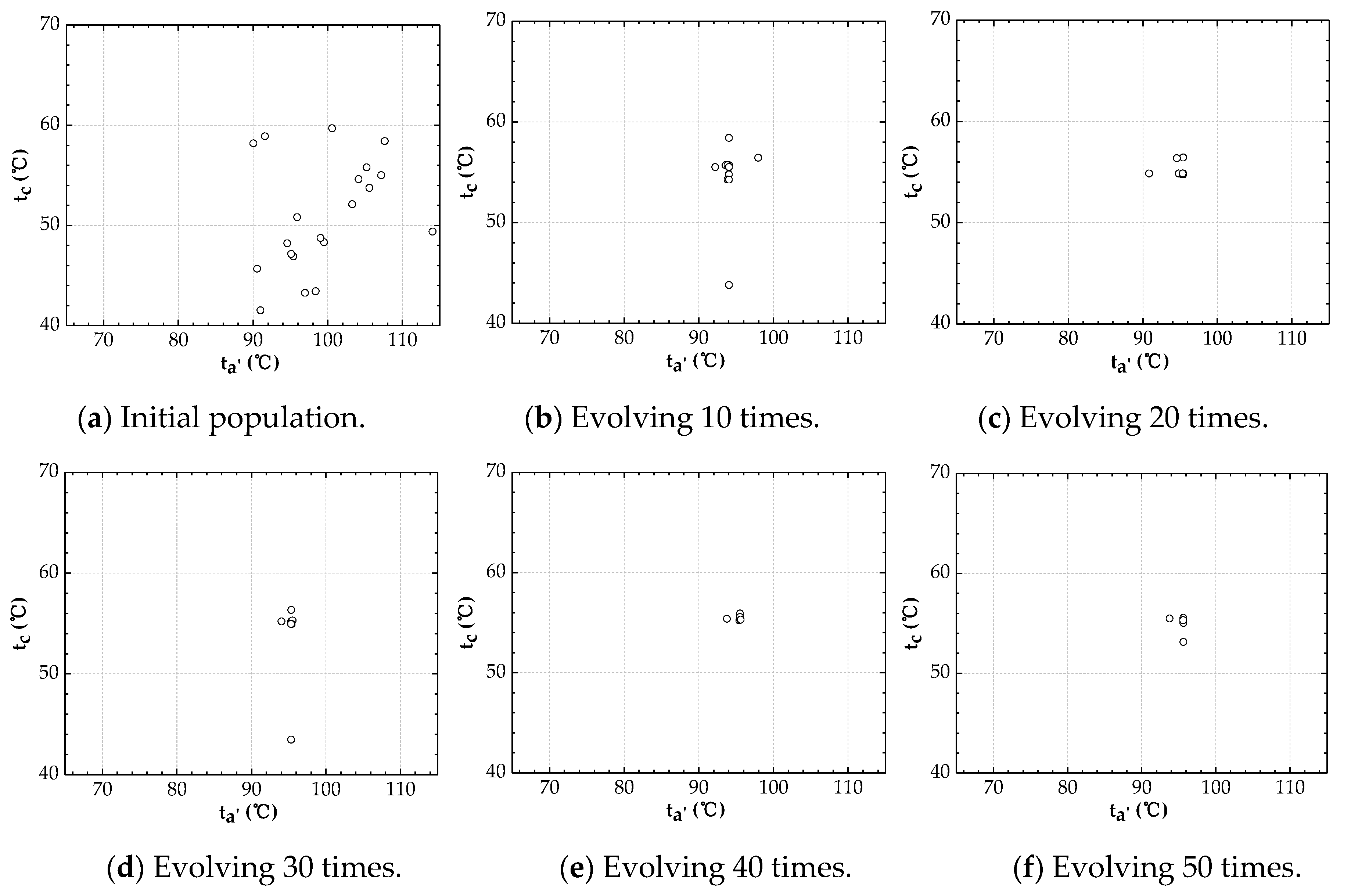





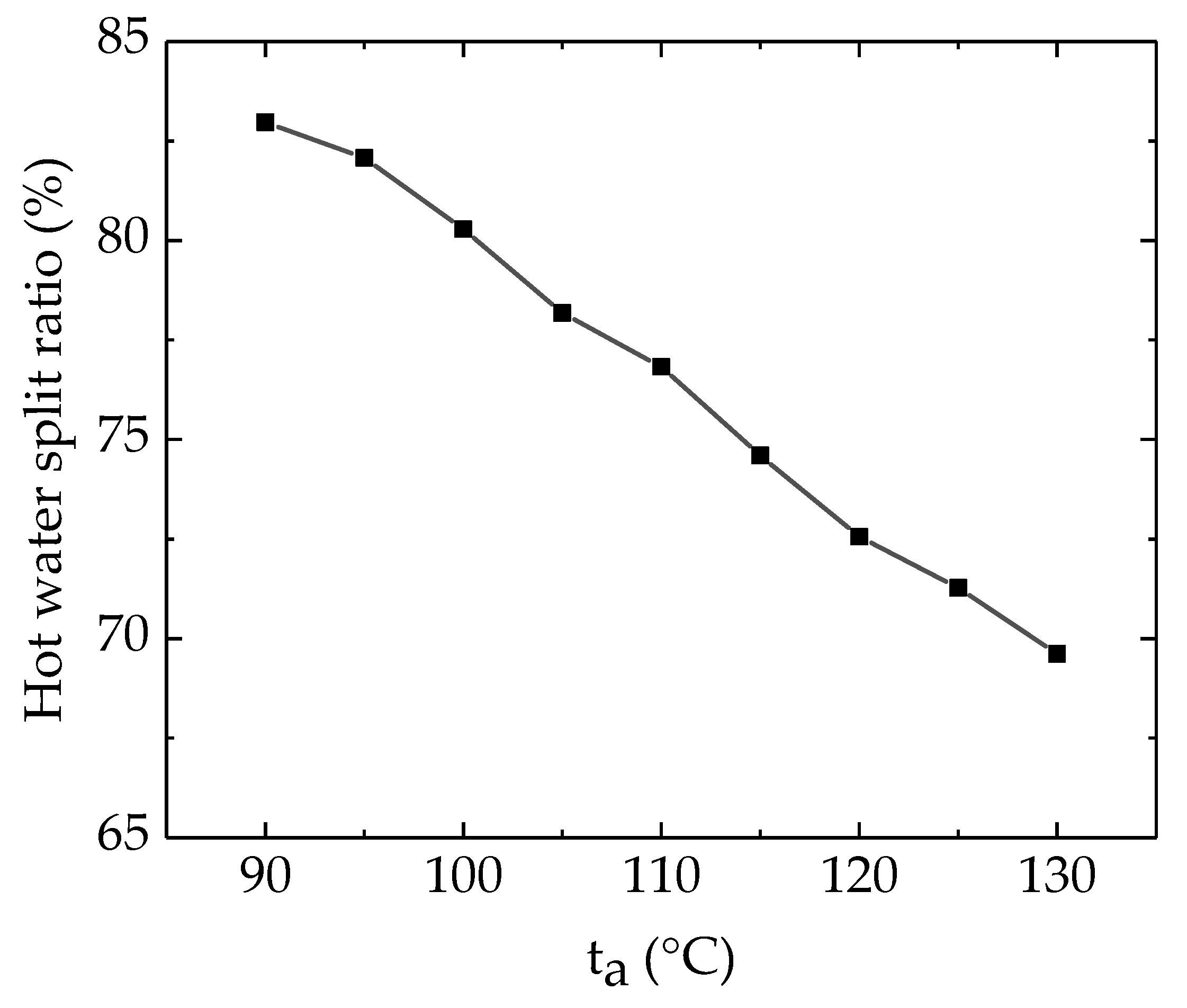
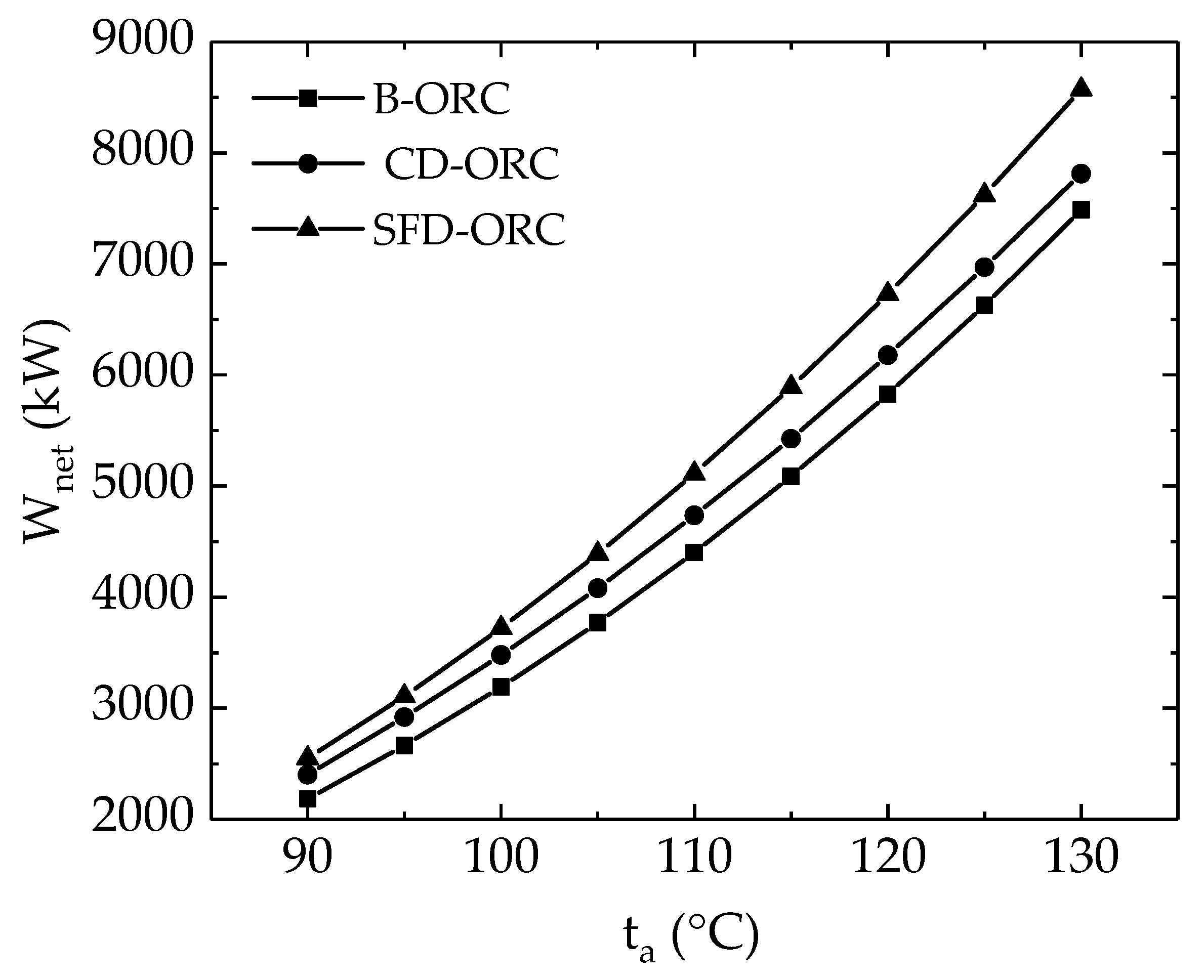
| Parameters | Value |
|---|---|
| Ambient temperature (°C) | 25 |
| Ambient pressure (kPa) | 101.3 |
| Condensation temperature (°C) | 30 |
| Cooling water inlet temperature (°C) | 25 |
| Cooling water outlet temperature (°C) | 30 |
| Hot water mass flow rate (kg/s) | 324.2 |
| Hot water inlet temperature (°C) | 90–130 |
| Pinch temperature difference (°C) | 3 |
| Working fluid pump isentropic efficiency | 70% |
| Working fluid pump equipment efficiency | 75% |
| Cooling water pump isentropic efficiency | 80% |
| Cooling water pump equipment efficiency | 90% |
| Expander isentropic efficiency | 85% |
| Expender equipment efficiency | 95% |
| Population size | 20 |
|---|---|
| Maximum number of generations | 50 |
| Precision of variables | 20 |
| Objective function | Wnet |
| Selection method | stochastic universal sampling (SUS) |
| Crossover probability | 0.7 |
| Mutation probability | 0.01 |
© 2020 by the authors. Licensee MDPI, Basel, Switzerland. This article is an open access article distributed under the terms and conditions of the Creative Commons Attribution (CC BY) license (http://creativecommons.org/licenses/by/4.0/).
Share and Cite
Wang, S.; Yuan, Z. A Hot Water Split-Flow Dual-Pressure Strategy to Improve System Performance for Organic Rankine Cycle. Energies 2020, 13, 3345. https://doi.org/10.3390/en13133345
Wang S, Yuan Z. A Hot Water Split-Flow Dual-Pressure Strategy to Improve System Performance for Organic Rankine Cycle. Energies. 2020; 13(13):3345. https://doi.org/10.3390/en13133345
Chicago/Turabian StyleWang, Shiqi, and Zhongyuan Yuan. 2020. "A Hot Water Split-Flow Dual-Pressure Strategy to Improve System Performance for Organic Rankine Cycle" Energies 13, no. 13: 3345. https://doi.org/10.3390/en13133345




